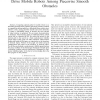Free Online Productivity Tools
i2Speak
i2Symbol
i2OCR
iTex2Img
iWeb2Print
iWeb2Shot
i2Type
iPdf2Split
iPdf2Merge
i2Bopomofo
i2Arabic
i2Style
i2Image
i2PDF
iLatex2Rtf
Sci2ools
ICRA
2007
IEEE
2007
IEEE
Minimum Wheel-Rotation Paths for Differential Drive Mobile Robots Among Piecewise Smooth Obstacles
— Computing optimal paths for mobile robots is an interesting and important problem. This paper presents a method to compute the shortest path for a differential-drive mobile robot, which is a disc, among piecewise smooth and convex obstacles. To obtain a well-defined notion of shortest, the total amount of wheel rotation is optimized. We use recent characterization of minimum wheel-rotation paths for differential-drive mobile robots with no obstacles [4], [5]. We reduce the search for the shortest path to the search on a finite nonholonomic visibility graph. Edges of the graph are either minimum wheel-rotation trajectories inside the free space or trajectories on the boundary of obstacle region. Vertices of the graph are initial and goal configurations and points on the boundary of obstacle region. We call the search graph a nonholonomic visibility graph because the jump condition of the Pontryagin Maximum Principle gives a necessary condition which is reminiscent of bitangency i...
| Added | 03 Jun 2010 |
| Updated | 03 Jun 2010 |
| Type | Conference |
| Year | 2007 |
| Where | ICRA |
| Authors | Hamid Reza Chitsaz, Steven M. LaValle |
Comments (0)

